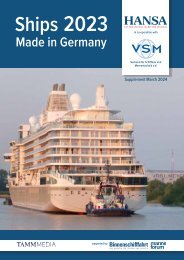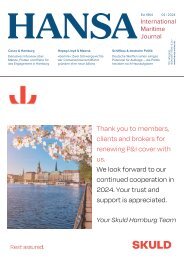HANSA 05-2017
Special Focus: NorShipping 2017 | HullPic Review | COMPIT Preview | Leonhardt & Blumberg | Sewol salvage | Tugs | German Banks | Tanker | Maritime Politics | Offshore Tender
Special Focus: NorShipping 2017 | HullPic Review | COMPIT Preview | Leonhardt & Blumberg | Sewol salvage | Tugs | German Banks | Tanker | Maritime Politics | Offshore Tender
Create successful ePaper yourself
Turn your PDF publications into a flip-book with our unique Google optimized e-Paper software.
Nor-Shipping<br />
Centralization through regionalization<br />
Short sea shipping services that are needed along the Norwegian coast are challenged by<br />
low volumes, multiple port calls and competition from liner companies. Thus, the country<br />
seeks a new port strategy for the future<br />
Traditional port costs, with respect to<br />
handling cargo, port dues and terminal<br />
operations, often exceed 30% of total<br />
door-to-door distribution costs. Consequently,<br />
the Norwegian government<br />
commissioned a report asking for recommendations<br />
to the country’s future port<br />
strategy. Researchers of Molde University<br />
College, Norway, and Edinburgh Napier<br />
University, United Kingdom, presented<br />
their findings at the 2016 IAME conference<br />
in Hamburg, giving an insight into<br />
the state of Norwegian port and cargo distribution<br />
system.<br />
The port of Oslo is by far the largest port<br />
in terms of container throughput (2003–<br />
2014), with over 210,000 TEU handled in<br />
2014. In addition, there are several ports<br />
that are serving Eastern Norway and the<br />
greater Oslo region: Borg, Moss, Drammen,<br />
Larvik and Grenland. Ships calling<br />
these ports also call the southern port of<br />
Kristiansand. Norway can be split into<br />
Oslo, Oslo region, western and northern<br />
ports, with a low share of container traffic<br />
in the north. The ten biggest ports hold<br />
85% of the country’s container market.<br />
Oslo alone has a market share of 29%, followed<br />
by Larvik and Ålesund (9% each).<br />
While there is a sharp increase in growth<br />
for Oslo region ports in 2008, at the same<br />
time there is a decrease for Oslo. Levels for<br />
both fall distinctively in 2009 likely as a result<br />
of the financial crisis. The same trend<br />
shows again from 2012 and onwards. When<br />
the Oslo region increases sharply, the port<br />
of Oslo decreases and has stabilized at lower<br />
levels. Therefore a key point to understand<br />
is why the Oslo region ports are able<br />
to win the competition with a much bigger<br />
port and absorb the entire growth from<br />
2012–2014. There is no capacity problem in<br />
Oslo and indeed the port recently has commenced<br />
a significant expansion of capacity<br />
for containers.<br />
At national level, there is a clear progression<br />
towards port concentration from<br />
2003 to 2008 and then a deconcentration towards<br />
2014. This is also the case in the East<br />
of the country. There is a different story in<br />
Western Norway, with a continuing deconcentration<br />
across the time period, starting<br />
very slowly and then increasing in recent<br />
years. Therefore, Norway conforms to the<br />
predictions that port systems move towards<br />
concentration then deconcentration.<br />
To understand the dynamics of port<br />
choice, a number of shipping companies<br />
were interviewed. While transport time<br />
is a key factor for port choice this seems<br />
not to be the case for shipping lines serving<br />
the Norwegian market. It is not time that<br />
is critical, but frequency. Cargo volume is<br />
a dominant port selection criterion. Even<br />
small volumes can influence shipping lines<br />
decisions in a feeder system. Generally, the<br />
relatively low cargo volumes characterizing<br />
these port systems also cause regional<br />
markets to quickly reach their saturation<br />
point. The degree of competition at a port is<br />
an important factor evaluated by shipping<br />
lines before deciding to call a port or not.<br />
Several reasons can be found to why Oslo<br />
region ports have grown at the expense of<br />
the port of Oslo. First of all, there is the<br />
trend of production and logistical hubs being<br />
relocated to other areas in the region.<br />
Other issues such as inadequate railway<br />
connections and higher port charges may<br />
also have had an influence. One important<br />
aspect underlined by interviewed shipping<br />
companies, is that bigger ports may not adjust<br />
as easily to the requirements of shipping<br />
lines in terms of flexibility and implementing<br />
new customer-oriented solutions,<br />
as they think secondary ports may not pose<br />
a real threat. The port of Oslo is obviously a<br />
The Port of Oslo is losing ground to smaller competitors in the region<br />
Photo: Harald M. Valderhaug<br />
42 <strong>HANSA</strong> International Maritime Journal – 154. Jahrgang – <strong>2017</strong> – Nr. 5

















